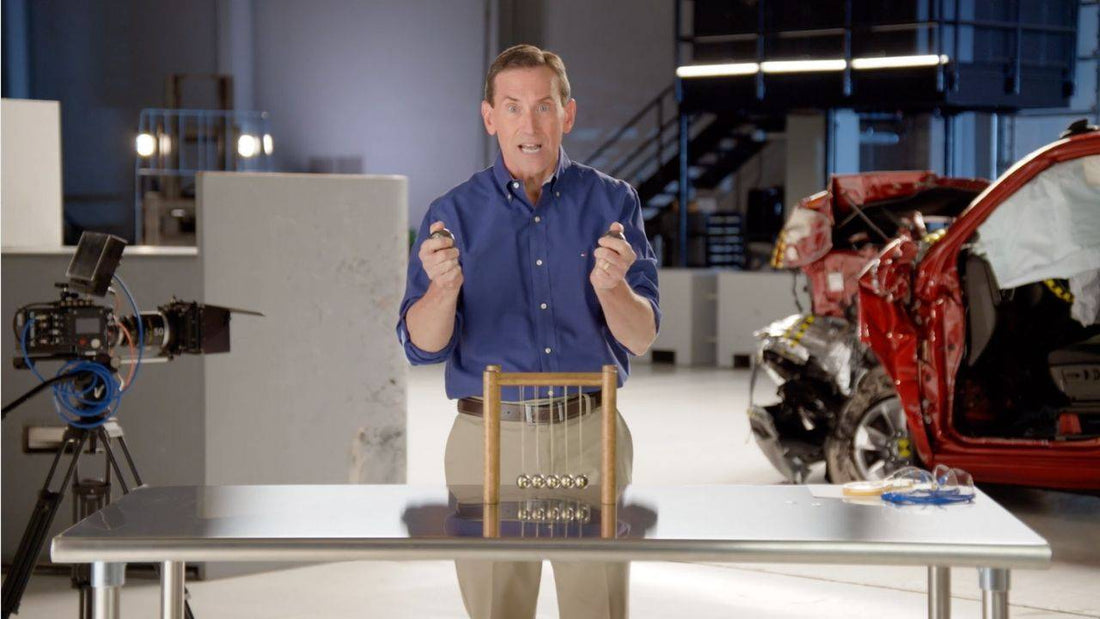Explore the science of car crashes at classroom.iihs.org
Featured Products
Newton’s Cradle is a popular device that shows the energy transfer between moving spheres and a group of stationary spheres. Many students have seen this, but you should also have it in your collection of physics toys.
The first demo shown is one sphere swinging into the group and then one swinging out from the group. The presenter explains that this is an example of the conservation of energy.
Pause the video and write the following equations for this interaction on your board:
KE = ½ m v2 + energy before collision = energy after collision
Ask the students to observe Newton’s Cradle for at least 30 seconds. Then pose the question, “What is happening? Is this a violation or exception to the rule of conservation of energy?”
Next, ask students to form a hypothesis and then “check your neighbor” to find their best explanation.
Now ask a random student, “Share the explanation given by your neighbor." Students should identify that the collisions produce sound, perhaps some heat, and also some friction with the air.
With the video still in pause mode, ask, “What would happen if two spheres were swinging into the group?” Again, promote a discussion with a “check your neighbor” pedagogy.
Students will correctly predict that two will swing-out. Show this experiment and students will be pleased that their predictions are correct. We still have conservation of energy.
Ask your students “How does the equipment know to send two spheres out? Wouldn’t we still have energy conserved if one sphere swung out with greater speed?” (See explanation below* and answer this later!)
Suppose that we have one sphere swinging in from one direction and two swinging in from the opposite side? After a brief discussion, try it!
Resume the video or better yet, use a pair Colliding Spheres to duplicate the activities shown in this video with your students. After you have crashed the spheres together, pass the paper around the classroom so everyone can see and smell the burned paper! The smell makes this a memorable demo.
A student with eyes closed holding the paper will indeed hear, smell, and feel the vibrations of the paper.
Repeat the collision with a piece of aluminum foil to show the effect of the energy transfer to the foil. Ask the students why the foil does NOT burn like the paper. (The metal foil conducts the heat much faster than the paper so the heat generated by the collision quickly spreads over a larger area.)
Point out that the indentations on the aluminum foil are concentric circles. Ask students, “Why the shapes are not concentric triangles or concentric squares?” (The energy moves in all directions at the same speed – like dropping a square block into a pool of water which always produces circular waves!)
Show the end of the video of the car crashing into a fixed barrier. Notice that the engine compartment is crushed by good design! All vehicle makers purposely design a solid “passenger cage” inside a crushable vehicle. Cars can be replaced easier than people. Each year over 38 thousand Americans are killed in vehicle crashes so be alert when driving.
Also, point out that the driver is a “smart” dummy. The dummy is part of a family: infant size dummies, child size dummies, teen dummies, and mom and dad size dummies. The dummies are fitted with sensors to measure the accelerations in the feet, knees, elbows, etc. with multiple sensors in the neck and head.
The video was shot at the Insurance Institute of Highway Safety (IIHS). IIHS is a non-profit research institute in Ruckelsburg, VA about an hour drive from Washington, DC. They do crash testing of new vehicles and publish their results for the public.
Note* - The reason that the same number of spheres swing out that came is because both energy and momentum must be conserved in every collision.
Conservation of energy would require that the one out had 1.4 times the speed of the “in” spheres, but the momentum of one out with 1.4 times the speed would not match the starting momentum.
Ergo. Let mass = 1 unit and inward impact speed be 1 unit, then two in and one out for the conservation of energy would be:
KE before collision = KE after collision
½ m v2 = ½ m v2
½ (2m) (1v)2 = ½ (1m)(1.4v)2 (note the faster velocity is required)
1 m v2 = 1 m v2 is okay, but for cons. of momentum:
momentum before momentum after
2m v 1m (1.4v) are NOT equal!!!
Make Newton’s Cradle available for students to play. Encourage their creatively. They will be delighted with their results: (Two in from one side and three in from the opposite side, or try to produce the sound of a horse galloping, etc.)
The DVD Understanding Car Crashes is a great resource to demonstrate how scientists and engineers apply physics concepts to design safety into vehicles. The video explains the concepts of Newton’s Laws, momentum, and energy as they relate to vehicles.
Leave your comments, questions, or suggestions in the comments section below!


